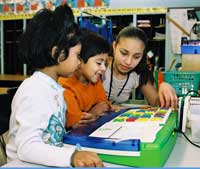• by Juanita C. García , Ph.D. • IDRA Newsletter • April 2004 • 
The teacher wondered how her group of middle school tutors would react to reading predictable children’s books to their elementary “tutees.” Would they enjoy the books or would they think they were too mature to do the activities in the lesson? She wondered if the tutors would enjoy being read to as she modeled the dramatic reading of a children’s literature book. Would they volunteer to read their books to the rest of the class? And, most important of all, would they read to their tutees in the elementary school?

The tutors were participants in the IDRA Coca-Cola Valued Youth Program, an internationally-recognized cross-age tutoring program in schools across the United States and Brazil. The program was created by the Intercultural Development Research Association. In the program, secondary school students who are considered at risk of dropping out of school are placed as tutors of elementary school students during one class period each day.
This enables the older students to make a difference in the younger students’ lives. With a growing sense of responsibility and pride, the tutors stay and do better in school. The program supports them with positive recognition and instruction.
The teacher was working with the tutors as they planned their upcoming tutoring sessions. She began the lesson by leading a discussion around four questions: Do you ever read to your tutees? Do you ever have trouble getting them to listen and pay attention to the story? How do you prepare them, get them ready for reading? How do you keep them interested in the story?
To her surprise, most of the students said they read to their tutees and were ready to learn different ways of preparing them for reading and keeping them interested in the story. They were so entranced with the dramatic reading of the key literature selection that they began to participate in the repeated readings of the story.
Once she knew she had captured their emotional attention, she explained to them that she would be sharing some techniques for getting their tutees ready for and excited about a story and for keeping their interest in the story through several readings.
Tutoring Reading
Beginning readers need to read a story several times before they can read it on their own, but this can seem boring unless we do it creatively.
The most common type of support in reading is tutoring. So, as part of the Coca Cola Valued Youth Program curriculum, a basic skills instruction unit on tutoring reading is the focus to help tutors practice techniques designed to get tutees ready to read a book or story, read it with them, and use the story as a model for their own writing.
A big challenge schools face is in ensuring that all children become competent readers. Once young children experience problems in reading, they quickly fall behind their more skilled classmates in their ability to decode and comprehend text. This gap in reading skills can emerge as early as first grade and become stable over time (Stanovich, 1986).
The good news is that students can be explicitly taught to deliver effective tutoring in reading to younger peers. Not only does peer tutoring provide effective reading support, but the tutors also benefit academically from the time spent reviewing and practicing material with their tutees.
The Coca-Cola Valued Youth Program curriculum encourages critical and higher-order thinking skills. Organizing material to teach “facilitates long-term retention, as well as aiding in the formation of a more comprehensive and integrated understanding” (Cohen, 1986).
As their tutees improve, tutor’s concept of self improves. Making a meaningful contribution is a powerful experience. Valued Youth tutors stop skipping classes and behaving disruptively after they realize they are role models and are making a difference for their tutees (Supik, 1991).
Reading With Younger Children
The first technique the tutors learn is called pre-reading questions. These questions are about topics that are in the story. But they also are about something in the tutee’s own lives so that they can make connections between books and themselves. Some people call them “Have you ever…?” questions because many begin with this phrase.
But a more fun and interesting way to ask these or any questions is called think-pair-share. The cooperative learning structure provides everyone with a chance to share an answer after think time (Kagan, 1994).
The next step, after pre-reading questions, is to read the story aloud in a very dramatic way. The tutors should pretend that they are an actor on stage or on television and use their voices, their hands, their bodies, and the pictures in the book to make this first reading one that will bring the story alive.
Like actors, they should rehearse the reading several times. That is, they should get the story before they go to the classroom and practice reading it aloud to the other tutors or their parents or their teachers until they feel confident that they do it well. This is when teacher modeling of the dramatic reading is very critical.
The third step, after the pre-reading questions and the dramatic read aloud, is to read the story again, stopping at key places to see if the students can supply the right word. In the last reading, tutees are supplied with word cards and expected to stand up and say the appropriate word.
After summarizing the recommended sequence of steps to be used when reading with tutees, each team of four tutors is given a predictable book to read. They write three to five pre-reading questions for it, practice a dramatic reading for it, and create word cards. Predictable stories are those with repeated language patterns that enable children to predict the actions and words coming next.
At the end of the task, each team models a guided reading session for the whole group, having one student play the role of the teacher and the other three the role of the tutees. Assessment of the task involves the rest of the students as they complete a Guided Reading Assessment Form when the teams of four model their guided reading session for the whole class. The assessment form is a rubric created to rate how well teams presented their task.
Examples of Pre-Reading Questions
Key literature for the “Reading to Your Tutees” lesson includes That’s Good! That’s Bad! by Margery Cuyler. In this story, a little boy has a series of adventures and misadventures with a bunch of wild animals. The pre-reading questions created for the story are the following: Have you ever been to a zoo? Do any animals scare you? Do you like lions? How do you feel about snakes? Have you ever had a bad day?
These questions were used to model and guide the tutors through the procedures of the lesson. Then the groups were given predictable books to read and to generate their own questions.
Below are examples of the pre-reading questions that the tutors generated for their books. A brief summary of the books is followed by examples of the tutors’ questions.
- A Peacock Ate My Lunch, by Craig B. McKee and Margaret Holland – A little girl has many secret animal friends who all come out to play and then they go away. Pre-reading questions are: Do you have secret friends? Have you ever seen a peacock? Where would you find a peacock? Have you ever had a friend who went away?
- I Want to Learn to Fly!, by Judy Barron – A young girl imagines all the places she would go if only she could fly. The pre-reading questions are: Has anyone wanted to fly like a bird before? Are you scared of heights? Have you ever dreamed you could fly? Where would you go if you could fly? What kinds of wings would you like?
- Drummer Hoff, by Barbara Emberley – This story is a cumulative folk song in which seven soldiers build a magnificent cannon, but Drummer Hoff fires it off. The pre-reading questions are: Have you ever played the drums? Have you ever read a rhyming book? Do you know any rhyming words? What word rhymes with drums?
- If You Give a Pig a Pancake, by Laura Numeroff – Chaos is the order of the day when an accommodating little girl tires to keep up with the whims of a busy little pig. The pre-reading questions are: Do you like pancakes? Have you ever seen a real pig? Do you have pigs at home? Do you like syrup on your pancakes? What would happen if you gave a pig a pancake?
- Together, by George Ella Lyon – This is an illustrated poem about friendship and togetherness. The pre-reading questions are: What kinds of friends do you have? Do you learn anything from your friends? Are you a friendly person? What is a friend?
According to the National Reading Panel Report, question generation is one of seven strategies that appear to have a firm scientific basis for improving comprehension. This strategy helps readers who do not know how to generate questions or inferences learn to generate and answer inferential questions (2000).
The eighth grade tutors learned how to use these strategies like professional teachers. They exceeded expectations. These students in at-risk situations demonstrated a real desire to help their tutees. They participated, interacted with each other, laughed together, and learned together. They truly are Valued Youth.
Resources
Cohen, J. “Theoretical Considerations of Peer Tutoring,” Peer and Cross-Age Tutoring, ERIC Digest, Number 79 (1986).
Green, C. Reading to Your Tutees (San Antonio, Texas: Intercultural Development Research Association, 2002).
Kagan, S. Cooperative Learning (San Clemente, Calif.: Kagan Cooperative Learning, 1994).
The National Reading Panel Report. National Institute for Literacy (Washington, D.C.: U.S. Department of Health and Human Services, 2000).
Stanovich, K.E. “Matthew Effects in Reading: Some Consequences of Individual Differences in the Acquisition of Literacy,” Reading Research Quarterly, 21, 360-407 (1986).
Supik, J. “Coca-Cola Valued Youth Program,” IDRA Newsletter (San Antonio, Texas: Intercultural Development Research Association, October 1991).
Juanita C. García, Ph.D., is an education associate in the IDRA Division of Professional Development. Comments and questions may be directed to her via e-mail at feedback@idra.org.
[©2004, IDRA. This article originally appeared in the April 2004 IDRA Newsletter by the Intercultural Development Research Association. Permission to reproduce this article is granted provided the article is reprinted in its entirety and proper credit is given to IDRA and the author.]



